Pekka Buttler, 08/2024

Specifications
The table below summarizes the lens’ key specifications (measurements based on pictured, last version of the lens):
| Brand: | Vivitar (Series 1) | Lens name | 70-210MM 1:3,5 macro focusing auto zoom |
| Focal length(s)1 | 70-210 mm | Angle-of-view2 | 34 ° – 11 ° |
| Maximum Aperture | f/3.5 | In Production | 1973–1981 |
| Lens mount (this lens) | Canon FD | Other lens mounts | multiple3 |
| Length4 | 165 mm | Diameter5 | 78,2mm |
| Filter ring diameter | 72 mm | Weight | 954 grams |
| Lens element count | 15 | Lens group count | 10 |
| Aperture blades (S/R/C)6 | 6 S | Focus throw | 170 ° |
| Minimum focusing distance | 195 cms | Maximum magnification | 1:7.2 @ 210 mm (1:2.2 in macro mode) |
| Has manual aperture ring | YES | Has Manual focus ring | YES |
| Aperture mechanism type | auto | Aperture click stops 7 | 3.5••5.6•8•11•16-22 |
Historical notes:
• This lens is part of Vivitar’s premium ‘Series 1’ lineup. In fact, it is one of the first half dozen lenses that were specifically designed by Vivitar to combine affordability with quality.
• It’s a tele-zoom lens that ranges from 70 mm (short tele) to 210 mm (tele) and does so keeping a constant maximum aperture (f/3.5). Today pro-level tele zooms typically have a constant maximum aperture half a stop brighter (f/2.8), but for the mid 1970s’ a constant f/3.5 max aperture was clearly pro-level spec8.
• To further illustrate this lens in context: Simultaneously with the introduction of this lens (1973), the best the big brand competition had to offer were:
– Canon: 100–200/5.6 (2x zoom instead of 3x zoom; 1.5 stops dimmer) [data sheet]
– Konica: 80–200/3.5 (narrower zoom range same brightness and 1,2 kilogram brick) [data sheet]
– Konica: 65–135/4 (2x zoom instead of 3x zoom; 0.5 stops dimmer) [data sheet]
– Minolta: 80–200/4.5 (10 mm off the zoom range at both ends; 2/3 stop dimmer)
– Nikon: 80–200/4.5 (10 mm off the zoom range at both ends; 2/3 stop dimmer)
– Olympus: 75–150/4 (2x zoom instead of 3x zoom; 0.5 stops dimmer)
– Pentax: 85–210/4.5 (15 mm longer at the wide end; 2/3 stop dimmer)
– Topcon: 87–205/4.7 (17 mm longer at the wide end, 5 mm shorter at the long end; one stop dimmer)
Further notes:
• There are two different lenses that were sold under the identical mainline specs’ (“Vivitar Series 1 70-210 mm f/3.5”). These can be easily told apart by looking at the serial number on the name ring:
– The first version (this) has a serial number starting #22 and was manufactured by Kino Precision (Kiron).
– The second version has a serial number starting #37 and was manufactured by Tokina.
– opinions are divided regarding which of these versions is more attractive, but the first version is very readily available.
– See more information under versions.
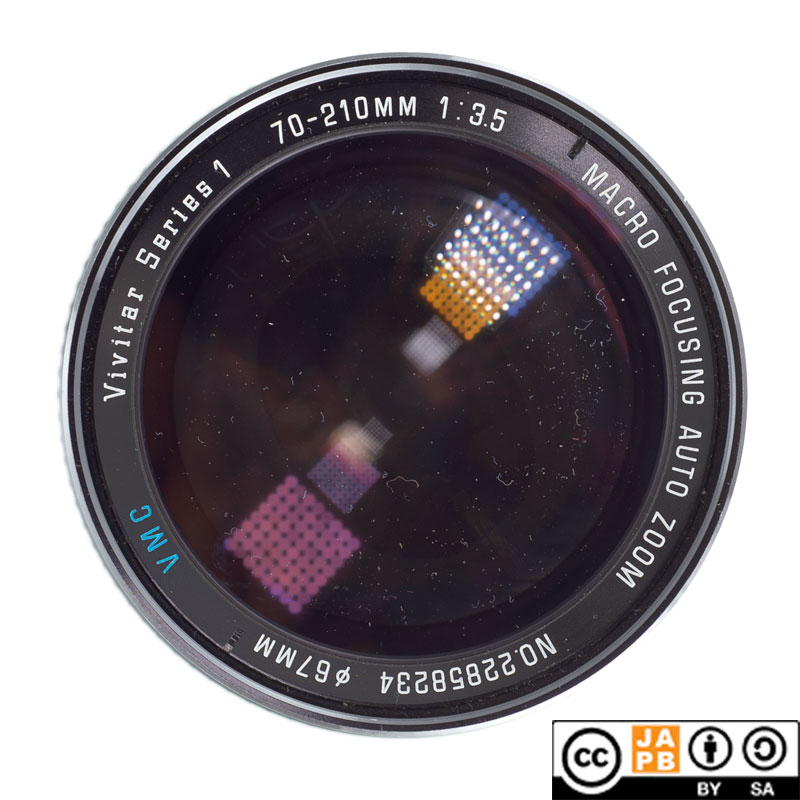
• Even though carrying pro-level specs, the lens was very affordable, leading to being produced in copious numbers. Due to used samples being readily available in combination with a disdain for early zooms, these lenses are today cheap as chips.
• Whenever you have a discussion about legacy zooms, there will be a handful of zooms that will be mentioned as being very good (despite being legacy zooms), and this lens will always gather mentions.
• The lens features a one-ring, push-pull design. This means that you adjust focal length by pushing or pulling on a ring and that you rotate the same ring to adjust focus.
• To zoom closer you pull the control ring towards the camera; to zoom out you push the zoom ring forward.
• The lens’ zooming action is internal, and the length of the lens does not change while zooming.
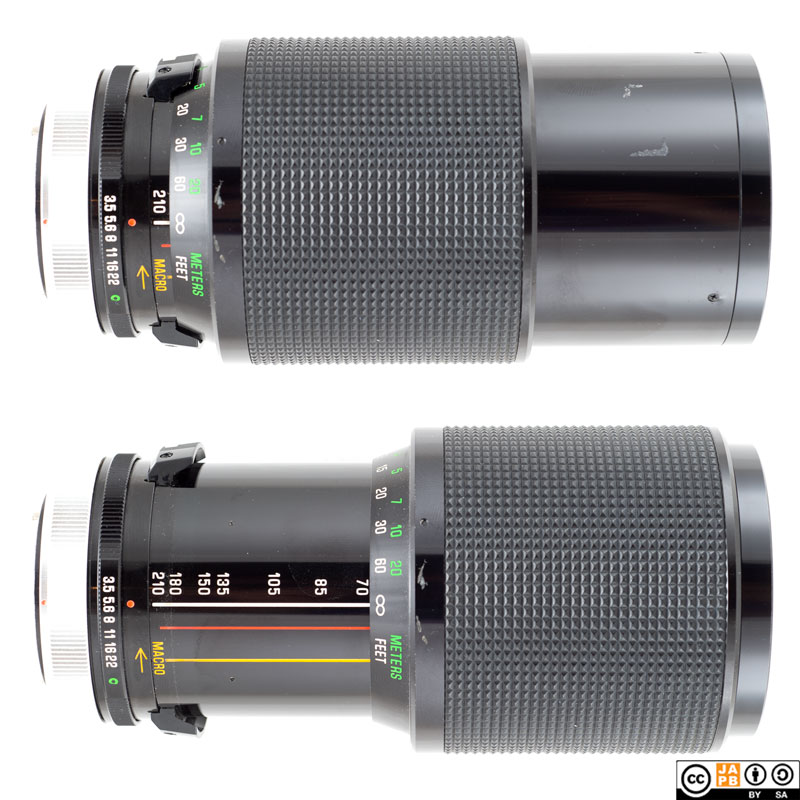
Bottom: Vivitar Series 1 70-210 mm f/3.5 (Kiron) zoomed at 70 mm and focused at infinity
• The lens offers intermediate numbers for focal lengths 70, 85, 105, 135, 150, 180 and 210.
• On the lens barrel you can see three coloured lines:
– A white line to indicate focus in full-spectrum photography
– A red line to indicate focus in infrared photography
– A yellow line to indicate focus in macro mode.
• However, the lens is nowhere near parfocal (meaning that you always need to refocus after changing zoom). Therefore also the focusing lines being straight is something of an illusion.
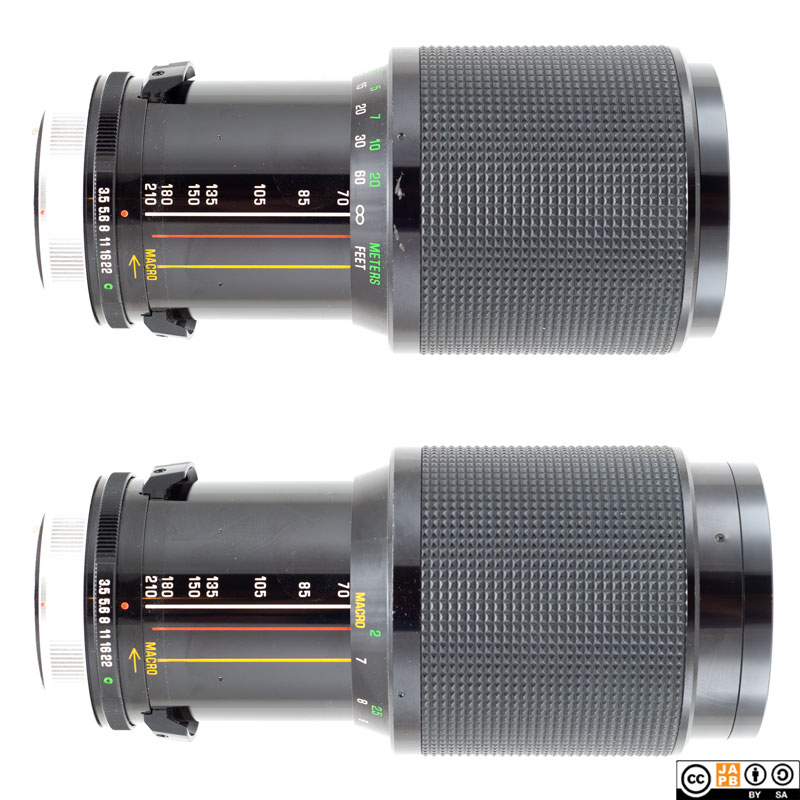
Bottom: Vivitar Series 1 70-210 mm f/3.5 (Kiron) zoomed at 70 mm and focused at MFD.
• The lens lengthens a bit when focused at minimum focusing distance.
• Also, the filter threads rotate during focusing.
• At almost two meters, the lens’ minimum focusing distance is a bit limiting (although not exactly unusual for early zooms).
• As partial compensation, the lens offers a macro mode.
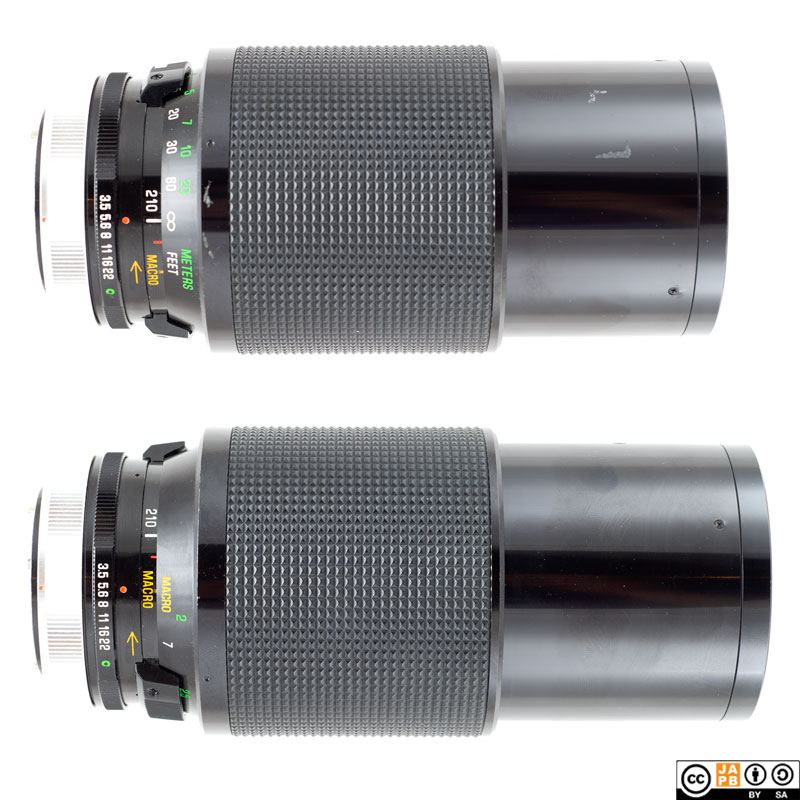
Bottom: Vivitar Series 1 70-210 mm f/3.5 (Kiron) zoomed at 210 mm, focused at MFD, with macro mode engaged.
• To engage the lens’ macro mode, it needs to be zoomed to 210 mm. Once there, grab the ‘wings’ of the narrow macro mode ring (one step forward of the aperture ring) with a thumb-and-forefinger pincer, and twist it to engage the macro mode.
Versions
Vivitar sold several Series 1 tele zooms in the 70-210 mm range, and it pays to discuss these for a moment:
1. Kino precision (#22), constant aperture, 1973–1981 (this lens)
This is the first and rather revolutionary design. This version is also the one people mean when they talk about ‘The’ Series 1 70-210. Many sources say the lens was introduced in 1975, but this is incorrect as it is already featured in Vivitar’s earliest Series 1 brochures and was introduced before the launch of the Contax/Yashica and Pentax K mounts.
Regarding variations within the 1st version, it important to remember, that it was manufactured for a lot of different mounts and therefore there is some variation in both the overall size of lenses for different mounts, as well as ergonomic difference in relation to aperture ring design.
2. Tokina (#37), constant aperture, 1981–1983
An equal spec lens to the Kino precision version, but significantly lighter and a tad sleeker. Not as highly regarded as the first version.
3. Komine (#28), variable aperture (f/2.8–f/4), ≈1984–1986
No longer a constant aperture zoom, but considered by some to have the best image quality of all.
4. Cosina (#09), variable aperture (f/2.8–f/4), ≈1987–1995
Also not a constant aperture zoom, featuring huge rubber focus ring and changed direction of zooming (push forward to zoom in).
5. Cosina (#09), variable aperture (f/2.8–f/4), Q-DOS, ≈1991–1995
Partially overlapping with version 4 and very similar to version 4, but now with Vivitar’s Q-DOS system that allowed the use of built-in red and cyan filters for use in generating 3-dimensional images.
6. Cosina (#09), variable aperture (f/2.8–f/4), Apochromatic, ≈1995–
A further development of version 4, now with added apochromatic lens elements to improve on chromatic aberration characteristics. This final version also had an autofocus sibling.
Besides these, Vivitar also sold a number of other 70-210 mm tele zooms outside of its premium Series 1 range.
History of Vivitar
Vivitar initially was the trade name used by Ponder & Best Inc. until Ponder & Best changed its name to Vivitar Corp. From the 1960s to the early 2000s the company contracted various (mostly Japanese) optical and electronics manufacturers to manufacture photographic gear to be branded as Vivitar.
You can read more details in the Vivitar company profile.
Adapting
n.B! The following applies to all Canon FD mount lenses.
This lens cannot be used natively on any current SLR or dSLRs. To use it in its native environment, you will need a Canon FD or FDn -mount film body.
Thanks to being a fully manual lens (manual aperture, manual focus), the lens can be adapted to all mirrorless cameras using a suitable adapter. However, for the adapter to allow the lens to stop down, you will need an adapter that can be set to engage the FD lens’ aperture control lever. Personally, this is my biggest gripe with the FD-mounts as this leads to what I refer to as the four-ring problem:
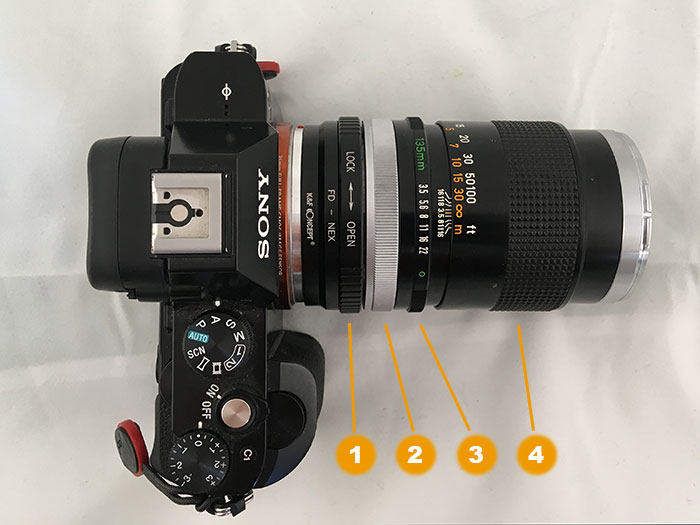
[1] Activation ring for aperture control
[2] Locking ring for breech-lock mount
[3] Aperture ring
[4] Focus ring
Note, that especially the first three rings are very close together.
Moreover, a large range of special adapters (helicoid adapters, tilt/shift adapters, speed boosters) for using Canon FD lenses on most mirrorless systems are available.
Using Canon FD lenses on dSLRs is a possibility, but is not problem free. Thanks to the relatively short flange focal distance of the Canon FD mount (at 42,0 mm, clearly shorter than that of any full-frame dSLR mount), any adapter will necessitate some corrective optics to achieve infinity focus.
Footnotes
- Focal length is (unless stated otherwise) given in absolute terms, and not in Full-frame equivalent. For an understanding of whether the lens is wide/tele, see ‘Angle-of-view’. ↩︎
- Picture angle is given in degrees (based on manufacturers’ specs) and concerns the diagonal picture angle. Rule of thumb:
> 90 ° ==> Ultra-wide-angle
70–90 ° ==> Wide-angle
50–70 ° ==> Moderate wide-angle
40–50 ° ==> ‘Standard’ or ‘normal’ lens
20–40 ° ==> Short tele lens
10-20 ° ==> Tele lens
5-10 ° ==> Long tele lens
< 5 ° ==> Ultra-tele lens ↩︎ - Including: Canon FD, Contax/Yashica, Konica AR, M42, Minolta SR, Nikon F, Olympus OM and Pentax K ↩︎
- Length is given from the mount flange to the front of lens at infinity. ↩︎
- Diameter excludes protrusions such as rabbit ears or stop-down levers. ↩︎
- S=straight; R=rounded; C=(almost)circular at all apertures. ↩︎
- Numbers equal aperture values on aperture ring; • intermediate click; – no intermediate click. ↩︎
- Trivia: The first constant f/2.8 aperture tele zoom was introduced by Nikon in 1982, and it was so demanding and expensive to manufacture that Nikon discontinued it after 3 years and only 1 600 pieces sold. ↩︎